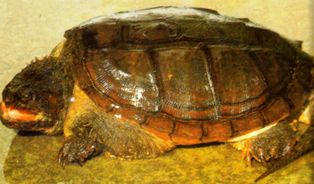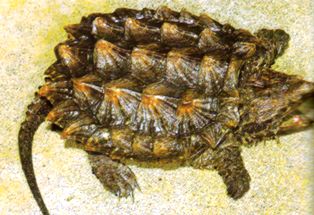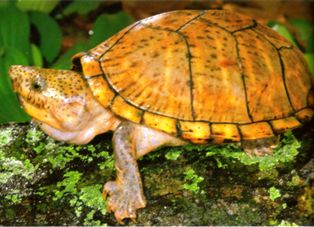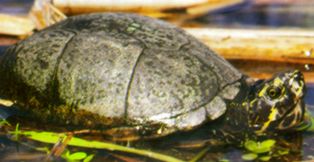Discover Florida Nature
It's time to explore the natural Florida


|
|
|
|
|
 Florida
Snapping Turtle- The Florida Snapping Turtle is found in ponds
and lakes with muddy bottoms and lots of vegetation throughout the
peninsula. The Florida Snapping Turtle can be recognized by the three
saw-toothed ridges running lengthwise down the top of its tail. It
reaches a maximum size of 18" and 35 pounds. It is an aggressive
predator, eating a wide variety of wildlife. Underwater, snappers are
generally inoffensive, but on land they will try repeatedly to bite if
approached. Their necks are quite long and they can snap and bite like
lightning. Even small snappers can inflict a painful wound with its
hooked beak Florida
Snapping Turtle- The Florida Snapping Turtle is found in ponds
and lakes with muddy bottoms and lots of vegetation throughout the
peninsula. The Florida Snapping Turtle can be recognized by the three
saw-toothed ridges running lengthwise down the top of its tail. It
reaches a maximum size of 18" and 35 pounds. It is an aggressive
predator, eating a wide variety of wildlife. Underwater, snappers are
generally inoffensive, but on land they will try repeatedly to bite if
approached. Their necks are quite long and they can snap and bite like
lightning. Even small snappers can inflict a painful wound with its
hooked beak Alligator
Snapping Turtle-
The Alligator Snapping Turtle is one of the oldest freshwater
turtles in the world. This turtle can be distinguished by its very large
head and the three prominent knobby ridges along its back. Found in
rivers and streams in the panhandle. It is one of the largest freshwater
turtles in the world, reaching a maximum size of 28" and weighing over
200 pounds. A large alligator turtle can easily severe a man's finger
off in just a quick bite! The alligator turtle has a unique way of
feeding. During the daytime, when there is sufficient light underwater,
the turtle will open its mouth and wiggle a reddish worm like growth on
its tongue as a lure to attract small fish. When a fish comes close to
investigate, the Alligator Snapping turtle will suddenly snap it up in
its powerful jaws. At night alligator turtles feed by foraging on
vegetation, snails, mussels and bits of animal flesh they may find. They
even eat small turtles. Snappers are rather primitive turtles and have
retained a long armored tail. Alligator
Snapping Turtle-
The Alligator Snapping Turtle is one of the oldest freshwater
turtles in the world. This turtle can be distinguished by its very large
head and the three prominent knobby ridges along its back. Found in
rivers and streams in the panhandle. It is one of the largest freshwater
turtles in the world, reaching a maximum size of 28" and weighing over
200 pounds. A large alligator turtle can easily severe a man's finger
off in just a quick bite! The alligator turtle has a unique way of
feeding. During the daytime, when there is sufficient light underwater,
the turtle will open its mouth and wiggle a reddish worm like growth on
its tongue as a lure to attract small fish. When a fish comes close to
investigate, the Alligator Snapping turtle will suddenly snap it up in
its powerful jaws. At night alligator turtles feed by foraging on
vegetation, snails, mussels and bits of animal flesh they may find. They
even eat small turtles. Snappers are rather primitive turtles and have
retained a long armored tail. Stinkpot
Turtle -The Stinkpot Turtle is so named because of two glands
on each side of the body that emit a musky smelling secretion when the
animal is captured or disturbed. The stinkpot is generally dark brown to
black with fine yellow stripes along the head and neck. It is very
aquatic and not seen wandering on land very often, although it will
often be seen climbing on branches of trees that overhang water. on its
underside, the Stinkpot Turtle seems to be more flesh than shell. The
small bottom shell, or plastron is joined to the carapace (top shell) by
a narrow bridge. In the wild this turtle feeds on fish, crayfish,
insects and carrion. Stinkpot
Turtle -The Stinkpot Turtle is so named because of two glands
on each side of the body that emit a musky smelling secretion when the
animal is captured or disturbed. The stinkpot is generally dark brown to
black with fine yellow stripes along the head and neck. It is very
aquatic and not seen wandering on land very often, although it will
often be seen climbing on branches of trees that overhang water. on its
underside, the Stinkpot Turtle seems to be more flesh than shell. The
small bottom shell, or plastron is joined to the carapace (top shell) by
a narrow bridge. In the wild this turtle feeds on fish, crayfish,
insects and carrion. Loggerhead
Musk Turtle- The preferred habitat of the beautiful little musk
turtle is clear, freshwater springs and spring runs. Large colonies can
be found in some of the big clear springs of North Florida. The
Loggerhead Musk Turtle has a habit of basking high above the water on
cypress knees or protruding snags. Front the front, its shell seems
almost triangular, except in older individuals, and its generally tan to
brown. The musk turtles large head is grayish with black spots. For a
small turtle, it can give a nasty bite! baby Loggerhead Musk Turtles do
no have large heads like the adult. The loggerhead is developed as a
result of years of crushing snails. Loggerhead
Musk Turtle- The preferred habitat of the beautiful little musk
turtle is clear, freshwater springs and spring runs. Large colonies can
be found in some of the big clear springs of North Florida. The
Loggerhead Musk Turtle has a habit of basking high above the water on
cypress knees or protruding snags. Front the front, its shell seems
almost triangular, except in older individuals, and its generally tan to
brown. The musk turtles large head is grayish with black spots. For a
small turtle, it can give a nasty bite! baby Loggerhead Musk Turtles do
no have large heads like the adult. The loggerhead is developed as a
result of years of crushing snails. Striped
Mud Turtle- The small Striped Mud Turtle can be recognized by
the three light stripes that run lengthwise down the top of it's shell.
This turtle's head is also striped. Striped mud turtles live near small
shallow bodies of water and are frequently seen crossing roads to forage
in wet meadows, particularly after rainstorms. The Striped Mud Turtle
eats a wide variety of food, and is sometimes seen feeding on manure,
which accounts for it being referred to as the "Cow Dung Cooter". This
turtles existence in the Florida Keys is precarious due to land
development. The striped turtle has a hinged plastron, or bottom shell,
but unlike the box turtle, mud turtles have two hinges, including one at
the rear, allowing the shell to be closed more tightly. Striped
Mud Turtle- The small Striped Mud Turtle can be recognized by
the three light stripes that run lengthwise down the top of it's shell.
This turtle's head is also striped. Striped mud turtles live near small
shallow bodies of water and are frequently seen crossing roads to forage
in wet meadows, particularly after rainstorms. The Striped Mud Turtle
eats a wide variety of food, and is sometimes seen feeding on manure,
which accounts for it being referred to as the "Cow Dung Cooter". This
turtles existence in the Florida Keys is precarious due to land
development. The striped turtle has a hinged plastron, or bottom shell,
but unlike the box turtle, mud turtles have two hinges, including one at
the rear, allowing the shell to be closed more tightly. Florida
Mud Turtle- The Florida mud turtle is a small brownish colored
turtle, with faint markings on the head and no color patterns on any
part of the shell. The bridge connecting the carapace to the plastron is
narrow, and there are two hinges on the plastron, allowing the ends of
the plastron to move and partially close the shell. The Florida mud
turtle, found through out the state, rarely moves away from its
freshwater habitat of small creeks, drainage ditches and marshes.
Growing only to five inches in length, the Florida Mud Turtle is a
petite turtle foraging off vegetation, snails, and mussels. Like all
living turtles, the Florida Mud Turtle has no teeth, but uses its hard
parrot like beak for cutting and crushing its food. Florida
Mud Turtle- The Florida mud turtle is a small brownish colored
turtle, with faint markings on the head and no color patterns on any
part of the shell. The bridge connecting the carapace to the plastron is
narrow, and there are two hinges on the plastron, allowing the ends of
the plastron to move and partially close the shell. The Florida mud
turtle, found through out the state, rarely moves away from its
freshwater habitat of small creeks, drainage ditches and marshes.
Growing only to five inches in length, the Florida Mud Turtle is a
petite turtle foraging off vegetation, snails, and mussels. Like all
living turtles, the Florida Mud Turtle has no teeth, but uses its hard
parrot like beak for cutting and crushing its food. |
|
|
Advertise | Privacy Statement | Dog Encyclopedia | Video |Contact | Alaska Nature |
|